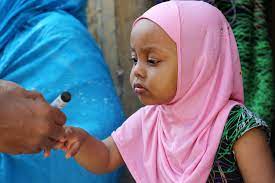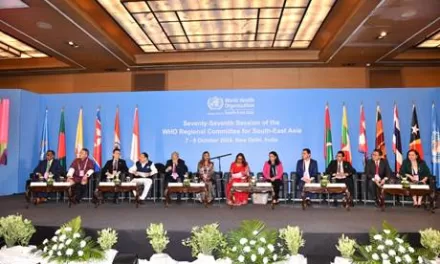
Situation at a Glance
Description of the Situation
On 20 and 27 December 2023, the Indonesian Ministry of Health notified WHO of two confirmed cases of circulating VDPV2. One case,from Klaten district, Central Java province, is a 6-year-old female, with a history of recent travel to Sampang district, East Java province. She developed acute flaccid paralysis (AFP) on 21 November 2023 and had previously received two doses of bivalent oral polio vaccine (bOPV) through routine immunization. The case had not received any dose of inactivated polio vaccine (IPV).
The genetic sequencing of isolates at the BioFarma National Polio Laboratory indicates cVDPV2 with 36 nucleotide changes, genetically linked to a case in West Java province, that was reported to WHO in March 2023.
The second case is reported from Pamekasan district in East Java province. The case is a one-year-old male with an onset of paralysis on 22 November 2023 with a history of bOPV vaccination (four doses) and one dose of IPV. The sequence result indicates 43 nucleotide changes with the Sabin 2 references.
Two environmental samples taken in Bangkalan district, East Java province, on 7 December 2023, also tested positive for cVDPV2. Sequence results showed 36 and 37 nucleotide changes.
Prior to these two cases of cVDPV2, in Central Java (1) and East Java (1), four cases of cVDPV2 infection had been reported previously from Indonesia. These four cases were reported, since 2022, in the following locations:
- Pidie, Aceh Province in October 2022
- Aceh Utara, Aceh Province in January 2023
- Bireuen, Aceh Province in January 2023
- Purwarkarta, West Java Province in February 2023
In Central Java, the 2022 data indicates over 95% coverage for bOPV4 and IPV1 at the provincial level, in Klaten district, Central Java province, the coverage for the four doses of bOPV and IPV1 was at 89.8% and 88.6% respectively in 2022. The Pamekasan district reported coverages of 88.1% for bOPV and 74.1% for IPV1, while the Bangkalan district reported 69.9% for bOPV and 53.7% for IPV1.
There are no hard-to-reach areas in the region. However, sociocultural barriers in East Java’s Madura community pose challenges to vaccination from vaccine hesitancy due to several reasons including fear of adverse effects, multiple injections and sometimes due to religious reasons.
Epidemiology
Polio is a highly infectious disease that largely affects children under five years of age, causing permanent paralysis (approximately 1 in 200 infections) or death (2-10% of those paralyzed).
The virus is transmitted from person-to-person, mainly through the fecal-oral route or, less frequently, by contaminated water or food. The virus multiplies in the intestine, from where it can invade the nervous system and cause paralysis. The incubation period is usually 7-10 days but can range from 4-35 days. Up to 90% of those infected are either asymptomatic or experience mild symptoms and the disease usually goes unrecognized.
Vaccine-derived poliovirus is a well-documented strain of poliovirus mutated from the strain originally contained in OPV. OPV contains a live, weakened form of poliovirus that replicates in the intestine for a limited period, thereby developing immunity by building up antibodies. On rare occasions, when replicating in the gastrointestinal tract, OPV strains can genetically change and may spread in communities that are not fully vaccinated against polio, especially in areas where there is poor hygiene, poor sanitation, or overcrowding. The lower the population’s immunity, the longer vaccine-derived poliovirus survives and the more genetic changes it undergoes.
In very rare instances, the vaccine-derived virus can genetically change into a form that can cause paralysis as does the wild poliovirus – this is what is known as a vaccine-derived poliovirus (VDPV). The detection of VDPV in at least two different sources and at least two months apart, that are genetically linked, showing evidence of transmission in the community, is classified as ‘circulating’ vaccine-derived poliovirus (cVDPV). Similar to wild poliovirus, cVDPVs can be of three types (1,2 or 3), the current outbreak in Indonesia is due to cVDPV type 2 (cVDPV2).
Public Health Response
In response to this cVDPV2 outbreak in Indonesia, several public health responses are underway.
As per protocol, detailed case investigation and risk assessment have been undertaken. Active case finding is being conducted in at least 200 households in both the community of the two current cases and neighboring areas. Furthermore, hospital record reviews have been performed and the identification of additional Environmental Surveillance (ES) sites is in process.
Coordination across country and regional levels with the global polio eradication initiative is ongoing. Efforts are ongoing to enhance and catch up on routine immunizations, focusing especially on two doses of IPV. In response to the outbreak, the government had requested the WHO-Director General’s approval for the release of novel oral polio vaccine type 2 (nOPV2). The DG has approved the release of more than 20 million doses of nOPV2 to conduct two rounds of supplementary immunization activities (SIAs) scheduled on 15 January 2024 and 19 February 2024.
Regular situation reports are being published on the WHO website and shared with neighboring countries.
WHO Risk Assessment
The overall risk is assessed as high at the national level. The country has strong capacity to respond which was demonstrated during the Papua cVDPV1 and Aceh and West Java cVDPV2 outbreaks. However, the population is susceptible to type 2 polioviruses following both the switch from trivalent OPV (tOPV) to bivalent OPV (bOPV), and the sub-optimal IPV vaccination coverage in Central Java, East Java, neighbouring Yogyakarta and several other provinces of Indonesia. Vaccine hesitancy among some populations complicates vaccination activities. There is regular population movement from Central Java, East Java and the neighbouring populous region of Yogyakarta, to other provinces within the country and vice-versa. Central Java and East Java have moderate to strong capacity within existing resources for implementing response measures.
At the regional level the overall risk is assessed to be moderate. Though there is no land-border from Central Java and East Java and limited cross-border population movement from the affected area, the virological analysis indicates that the virus may have been possibly circulating for some time and whole genome sequencing is still pending. This risk will be continuously assessed and will be reviewed according to the evolution of the situation.
WHO Advice
It is important that all countries, in particular those with frequent travel connections with polio-affected countries and areas, strengthen surveillance for AFP cases in order to rapidly detect any new virus importation and to facilitate a rapid response. Countries, territories and areas should also maintain uniformly high routine immunization coverage at the district level to minimize the consequences of any new virus introduction.
WHOs International Travel and Health advice recommends that all travellers to polio-affected areas be fully vaccinated against polio.
As per the advice of the Emergency Committee convened under the International Health Regulations (2005), efforts to limit the international spread of poliovirus, countries affected by poliovirus transmission are subject to Temporary Recommendations. To comply with the Temporary Recommendations issued under the PHEIC, any country that have had an importation of cVDPV2 with local transmission should (i) declare the outbreak as a national public health emergency, (ii) encourage residents and long-term visitors to receive a dose of IPV four weeks to 12 months prior to international travel, (iii) ensure that travellers who receive such vaccination have access to an appropriate document to record their polio vaccination status, (iv) further intensify efforts to increase IPV immunization coverage, including sharing coverage data, and (v) intensify regional cooperation and cross border coordination to enhance surveillance for prompt detection of poliovirus, and vaccinate refugees, travellers and cross border populations, according to the advice of the Advisory Group.
The latest epidemiological information on WPVs and cVDPVs is updated on the website of the Global Polio Eradication Initiative a weekly basis.
WHO advises against implementing any travel or trade restrictions based on the current information available on this event.
Further Information
- Global Polio Eradication Initiative: http://polioeradication.org/
- Poliomyelitis Fact sheets: https://www.who.int/health-topics/poliomyelitis#tab=tab_1
- WHO immunization dashboard: https://immunizationdata.who.int/
- GPEI Public health emergency status: http://polioeradication.org/polio-today/polio-now/public-health-emergency-status/
- International travel and health: https://www.who.int/travel-advice
- Vaccine-derived polioviruses: http://polioeradication.org/polio-today/polio-prevention/the-virus/vaccine-derived-polio-viruses/
- Polio outbreak in Sudan successfully stopped and declared closed: https://www.emro.who.int/polio-eradication/news/polio-outbreak-in-sudan-successfully-stopped-and-declared-closed.html
Citable reference: World Health Organization (11 January 2024). Disease Outbreak News; Circulating vaccine-derived poliovirus type 2 (cVDPV2) – Indonesia. Available at: https://www.who.int/emergencies/disease-outbreak-news/item/2024-DON500











